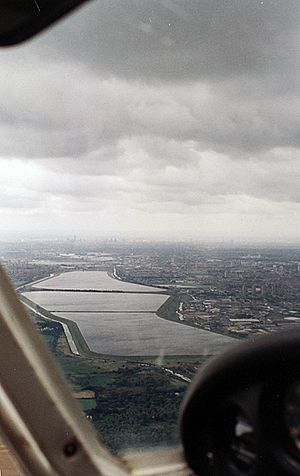Chingford Reservoirs facts for kids
| Site of Special Scientific Interest | |

Map of Chingford Reservoirs
|
|
| Area of Search | Greater London Essex |
|---|---|
| Interest | Biological |
| Area | 391.3 hectares |
| Notification | 1986 |
| Location map | Magic Map |

The Chingford Reservoirs are two large lakes found in London and Essex. They are named the King George V Reservoir and the William Girling Reservoir. These reservoirs are an important part of the Lee Valley Reservoir Chain. They help supply drinking water to many homes in the area.
Contents
What are the Chingford Reservoirs?
The Chingford Reservoirs are made up of two huge water bodies. These are the King George V Reservoir and the William Girling Reservoir. You can find them in parts of the Enfield and Waltham Forest in London. They are also partly in Epping Forest in Essex. These reservoirs are a key part of the Lee Valley Reservoir Chain. This chain helps manage water for the region.
Building the Reservoirs
Building the King George V Reservoir started in 1908. It was completed just four years later in 1912. Work on the William Girling Reservoir began in 1938. A company called John Mowlem & Co was the main builder. However, there were some tough technical problems. Also, World War II happened during its construction. Because of these challenges, the reservoir was not finished until 1951.
A Special Place for Wildlife
The Chingford Reservoirs cover a huge area of 391.3 hectares. That's about 967 acres! Because of their importance for nature, they are a biological Site of Special Scientific Interest (SSSI). An SSSI is a special protected area for wildlife. Most of this area (316.3 hectares) is in London. The rest (75 hectares) is in Essex.
The reservoirs are not very deep. This makes them a perfect home for many kinds of birds. You can see wildfowl, gulls, and wading birds here.
Birds You Might See
The reservoirs are a major spot for wildfowl in winter. Many birds come here to spend the colder months. This includes large groups of shovelers and great crested grebes. These populations are important for the whole country.
You can also spot many goldeneye ducks, tufted ducks, and goosanders. The reservoirs are also one of London's main places for gulls to rest. At one time, over 70,000 gulls have been counted here! Most of these were black-headed gulls, common gulls, lesser black-backed gulls, and herring gulls.
A Safe Haven for Birds
Since the 1950s, these reservoirs have been a safe place for wildfowl. Birds often come here when they are moulting in late summer. Moulting is when birds lose their old feathers and grow new ones. During this time, they can be more vulnerable.
Sometimes, large groups of great crested grebes also use the reservoirs for moulting. The reservoirs are also a stopover site for birds migrating in autumn and spring. This means birds stop here to rest and feed during their long journeys. Yellow wagtails even regularly breed here. In total, over 85 different types of wetland birds have been seen at this amazing site.

